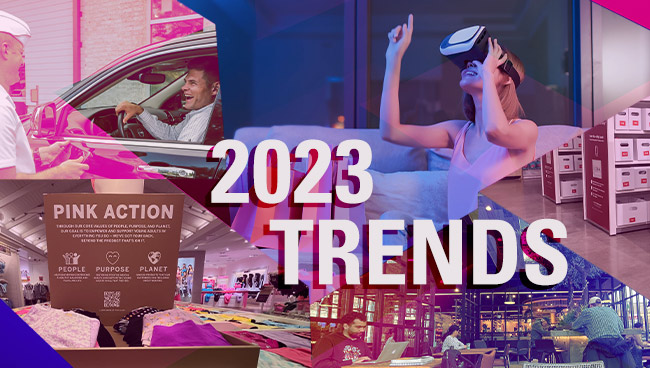WSL has been following the path of consumer shopping for decades. And through 2022, shoppers led us on a more focused, lifestyle-specific retail trip. To prepare for 2023, we culled through our How America Shops® and Retail Safari® market research, and zeroed in on seven big trends that predict what’s next for retail. Some will surprise you.
7 Customer Shopping Trends for Retailers and Brands
We’ve been following the path of Shopping Life® for 30-plus years, and of all the customer trends we’ve uncovered, these seven may be the most crucial for retailers and brands in 2023.
1. Stress will contribute to more shopping shortcuts
Stress was the leading obstacle to living a healthy life in 2022, affecting two-fifths of shoppers. A similar share, 37%, actively avoided stressors as a form of self-care. How does stress relief effect shopping? Shoppers will continue to find ways to shop faster and easier – to get the activities they have to do done easily so they can move onto the more relaxing things they prefer to do. Note that the pursuit of fast-and-easy shortcuts is guiding change in every part of the shopper’s life, from faster quick-serve meals to entertainment via streaming and the metaverse.

2. Surprise shoppers with mental health care.
Retailers are finding ways to include mental health services in their on-site clinics and through telehealth services. Overall, four in 10 consumers suffer from anxiety and depression, but the figure is much higher among Gen Z and Millennials – 60% and 43%, respectively – according to our “The Next Wellness Frontier” report. Retailers from drug chains to Victoria Secret are actively promoting mental health. Retail apps provide options as well – Nike has partnered with the TikTok Wellness Hub to raise awareness about mental health.

3. Retail can help cure loneliness.
A quarter of all shoppers, and 39% of Gen Z, experience loneliness. Our Retail Safari® scouts found these issues addressed in surprising yet subtle ways – in “happy stores” with natural light, invitations to join in organized activities such as hiking trips, or social spaces to share coffee at Central Market in Dallas, or a bottle of wine at Dom’s Kitchen & Market in Chicago.

4. Online and in-store shopping must be blended.
Six in 10 shoppers choose to shop in a physical store all or most of the time, but they use digital tools on those store trips. Millennials give digital support on a brick store shopping a rating of 7.5 on a scale of one to 10, according to our “The Role of the Store 5.0” report. They want apps to locate merchandise in the store and digital coupons. However, the foundations of the store experience, particularly the human element, should not be compromised. Shoppers across the board rank helpful, friendly employees as 7.8 in importance. Don’t miss the opportunity to interface with shoppers digitally, and take the moment to personally connect when they pick up online orders in-store or curbside.

5. Smaller formats enable faster, easier shopping.
We know from our research that the shoppers of the future use small formats such as Target Express, Neighborhood Market, Aldi, Lidl, Trader Joe’s and dollar chains. They prefer to get in and out fast, and perhaps have fewer choices to make the trip easier. Going even smaller, Dollar General is testing DGX and launched Popshelf to compete with Five Below – according to our Retail Safari® report, “The New Age of Dollar Channel Retail.” This demand for speed and ease inspired stores within stores that offer the convenience of a combined trip – such as Ulta boutiques and the Apple counter in Target.

6. Direct-to-consumer (and the metaverse) will get BIGGER.
DTC channels, including social media and livestreaming, are generating real sales beyond the predictable categories of fashion and tech. More than 45% of shoppers buy beauty, health and food items on DTC and social media, our “Planned Disruption” report shows. The report unveiled opportunities in the metaverse, as well: Three in 10 shoppers now use virtual reality and 75% have made virtual purchases, such as attending concerts, fitness classes and buying apparel for their avatars. Are avatar beauty and wellness goods next?

7. The next shopper will pay more for a “human” customer experience.
Humanity has become vital to delivering a satisfying customer experience in the brick store. How is the “human store” embodied in your shoppers’ eyes? It’s about mixing digital with smiling employees, who look shoppers in the eyes and say “hello.” It’s about stores organized for quick-trip shoppers, with brands that establish emotional connections in the aisles. Today, Target and Ulta rank high among shoppers for their “human store” traits. It’s not hard to observe how they do what they do.
And Here’s What’s Next for You, Retailers and Brands
WSL follows the shopper into the future. Consumers tell us – and you – how they want to shop, and it’s up to you to use the digital and personal tools to organize the store in ways that make the trip quick, easy and stress-free. And, ultimately, encourage browsing in the categories where shoppers want to linger.
Reach Out to WSL For Custom Market Research
We keep our shopper trends analysis up to date, surveying shoppers on what’s next, and updating past sentiments, so retailers and brand scan be a part of the next frontier of Shopping Life™. To access all of our reports, visit our shopper research page.



